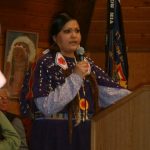Endangered Nez Perce, a Native American Language
If anyone has seen a documentary or Animal Planet episode about grizzlies bears, they can imagine the backdrop. The Ursus arctos comes to feed at crystal-clear rapids surrounded by tall and densely standing pines. The bears reach their claws into the water for fresh salmon and tear their prey apart on the boulders skewed around the stream. With a similar diet, and just as endangered, may bring to mind another animal from the American northwest yet like the title of this article it is the language of the Nez Perce tribe that is in danger. Now enter a host of new characters in the Animal Planet episode: Mr. Lewis and Mr. Clark, French trappers (who gave the tribe its name meaning “pierced noses”, actually a Chinook custom), and mixing time periods, the 2,000 strong that are current ethnic members of the tribe. However, only 200 speak their language of uncharacteristically long words. Two of their main reservations are in Colville, WA and Umatilla, OR. They can also be found in the western plains of Idaho where they are avid horse breeders.
The language is called Nimiipúu by the tribe, has downriver and upriver dialects, and belongs to the Plateau-Penutian sub-branch of Saphatian languages. There is some relationship with the Salish language to the south and more with the Palouse language, but otherwise Nez Perce is very distinct. The first dictionary was Jesuit from 1895, nine decades after their first contact with Europeans (Lewis & Clark) and six after ethnic studies by Reverend Asa Smith. Haruo Aoki produced a more contemporary dictionary (1994) with words drawn from ancestral stories that probably have helped the language survive as long as it has. Of course the entry for grizzly bear (x’axa c) is of special interest (see above). The African dish “couscous” is probably a good starter to pronounce the word “water” (kuus) because for feather (tu u’ynu), a cognate is more difficult to find. And to finish painting the picture, or hide, an important word is fish (Cúuy’em). A grilled sockeye salmon or steelhead could accompany that couscous nicely.The Latin script is normal for a language which never had a writing system, thus the aforementioned oral tradition.
The language’s structure is such that breathing might be difficult for a new adept. “Good morning, how are you?” is relatively normal, translated as “Ta’c meeywi, manaa wees?” but “ipnawyatolatalqima” stands for a whole sentence in English (He slowed down as he was moving along)! Haruo Aoki explains that the word is made up of six morphemes signifying the word is not merely a compound. Another characteristic, because these polysynthetic words could fill this page up rather quickly, is vowel harmony. Saphatian languages have all lost the feature which produces in Nez Perce, for instance, “Atúte” (father), “Anetúte” (my father), “Eméqe” (paternal uncle), and “Eneméqe” (my paternal uncle). Observe how the prefix meaning “my” harmonizes with the first vowel of the root word. Vowel harmony, which can also be found in the back vowel of words, is famous in Hungarian and Finnish languages. However, similar to the fate of the language itself, the feature is slowly disappearing from Nez Perce speech. Finally, the online language atlas displays one characteristic concerning the case marking of pronouns which is only shared with Hindi and one Southeast Asia language, an improbable panoply!
The language is being revitalized by recent programs to revert the decline in use. On the Umatilla reservation there are language classes, a few regional colleges cover the topic, and the Northwest Indian Language Institute is focusing on the use of Nez Perce at home. Surely, the watching eye of their hero Chief Joseph will oversee a return to limelight for Nez Perce. For now, the celebration of Native American month (December) is due…and here is the closest word for the occasion, “titóoqan léeheyn”. It means “Indian day” in Nez Perce.

Category: Foreign Language








